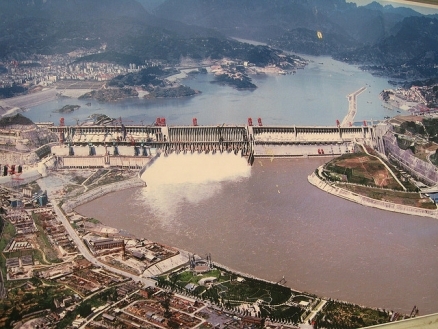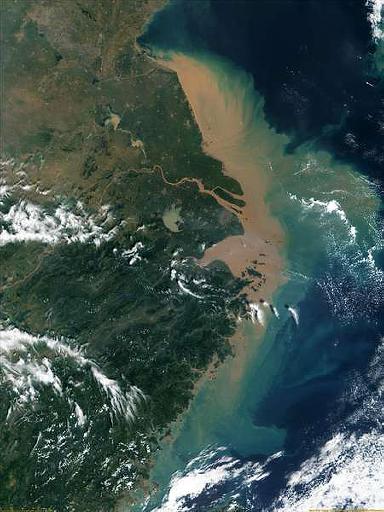Three Gorges Dam, China
Three Gorges Dam, China (30°44'18" North, 111°16'27" East), crosses the Yangtze River at Sandouping, Yichang, Hubei province, China. The dam’s name refers to the majestic limestone cliffs of the Qutang, Wu, and Xiling gorges, which stretch for about 200 kilometers (124 miles) from Fengjie, in Sichun province, to Yichang, in Hubei province, in China's heartland. The Yangtze is the longest river in Asia and the third longest in the world, running 6,211 kilometers (3,860 miles) from Qinghai Province in the Tibetan Plateau to the East China Sea near Shanghai. The river’s watershed is massive, spanning 1,722,155 sq.km (1,070,147 sq. miles) with nearly 400 million inhabitants.
On April 3, 1992, the National People's Congress of China approved the construction of the world's largest and most controversial hydroelectric facility at Three Gorges. The reservoir began filling on June 1, 2003, and construction is scheduled to be finished by May 2006. Full power generation will be reached in 2009. There are 26 power generating units planned, each with generating capacity of 700 megawatts (MW), which should produce an average of 84.7B kilowatt-hours per year (kWh/yr) from 2008 from a total generating capacity of 18,200 gigawatts (GW). Three Gorges would then surpass the 14,000MW Itaipú dam located on the Paraná River at the Brazil/Paraguay border. The latest government figures have put a price tag of US$25 billion on the project, although other estimates put the actual cost much higher.
The reservoir is 630km long and an average of 1.3km wide, while the dam wall is 185m high and almost as deep, stretching 2.3km across the valley. About 27 million cubic meters of concrete have gone into the structure since work began; that's more than eight times as much as has been poured into the Hoover dam on the Colorado River and twice the amount of concrete in the Itaipú dam. The Three Gorges project has been engineered to store over 5 trillion gallons of water and to withstand an earthquake of 7.0 on the Richter scale.
There about 50,000 other dams on the Yangtze River, mostly along tributaries of the main river, that were built in the past 50 years to create freshwater reservoirs. The freshwater storage capacity has skyrocketed from 0.06 cubic kilometers in 1950 to 180 cubic kilometers in 2002. When the reservoir behind the Three Gorges Dam is full, it will add up to 40 cubic kilometers to that total.
Contents
Benefits from the Three Gorges Project
To China's leaders, the Three Gorges dam will provide a foundation for the nation’s future economic prosperity. The power will also help meet China's rapidly growing energy demand. Just as important, the transmission lines that are being developed to transport electricity from the project to the rest of the country will help to create a national grid, with the Three Gorges at its heart.
Transportation of people and goods will be greatly enhanced. The reservoir will allow 10,000-ton freighters to enter the nation's interior, which currently limits access to boats under 1,500 tons. Vessels will be able to navigate from Shanghai up to Chongqing, around 2000km from the sea. It could become an even more important transport artery if sufficient facilities are put in place to integrate cargo transport on the river with major rail and road intersections. The government and companies involved in the development of the Three Gorges dam are also keen to promote the project by developing it as a tourist attraction. Tour boats now offer trips on the reservoirs in order to allow foreign and domestic tourists to appreciate what are being advertised as ‘lofty gorges projecting peaceful lakes’.
The dam is also intended to provide major flood control benefits. Historically, the population in the middle and lower reaches of the Yangtze River suffered tremendous losses from flooding both in human lives and property. For example, the massive flooding of the Yangtze River in 1931 caused more than 3 million deaths from flooding and starvation.
The government also notes that the dam's power generation potential of 84.7BkWh/yr is the energy equivalent of burning 50 million tons of coal or 25 million tons of crude oil. Thus, the switch to cleaner hydroelectric power would have the effect of cutting 100 million tons of carbon dioxide, up to two million tons of sulfur dioxide, ten thousand tons of carbon monoxide, 370,000 tons of nitrogen oxide, and 150,000 tons of particulates annually from the atmosphere.
Social and Environmental Concerns
Critics of the Three Gorges project argue that the project’s costs may outweigh the benefits, the latter of which have allegedly been exaggerated by the government. The Three Gorges Dam project has become a symbol of national unity and strength for the ruling communist party. As a result, critics charge that many of the controversies surrounding the project are glossed over or ignored. In an address to the engineers of the dam, then Premier Li Peng, himself a power engineer by training, said the scale of the project was proof to the world of China's newfound strength. "The damming of the Yangtze is of great political and economic significance ... It proves to the whole world the Chinese people's capability of building the world's first-rate hydroelectric project". The construction of the dam has thus become as much a celebration of Chinese nationalism and its political leadership as it is a massive power and engineering feat.
Foreign perception of the project has suffered from the reputation of its principal proponent in Beijing, Li Peng. Li, whom some historians hold responsible for the 1989 massacre in Tiananmen Square, championed the idea of the dam to guarantee China's energy supply amid the internal political repression and international isolation that followed Tiananmen. Li was the driving force behind the approval of the project in 1992 by the National People’s Congress despite no votes or abstentions from a third of the delegates—a rare display of dissent in the Congress.
Resettlement is a major source of controversy. More than 1.2 million will have to be resettled before the Yangtze valley is submerged. Entire villages and parts of major cities have been relocated. Critics claim that those forced out of the area have not been adequately compensated, particularly as the land they lost was highly fertile. But the government insists that the scale of its compensation package demonstrates its commitment to helping those affected improve their standard of living.
Upwards of 1,000 archeological sites will be submerged beneath the reservoir. Ancestral burial grounds and centuries-old temples, fossil remains, and archeological sites dating as far back as the Paleolithic Age risk being lost from public access and scholarly pursuit if they are not unearthed and relocated before the waters rise. The government has taken measures that it claims will mitigate these losses.
There is also concern about the impact the project will have on biological diversity. The baiji dolphin, the ancient river sturgeon and the finless porpoise depend on the Yangtze for their survival. The population of Siberian cranes in Poyang Lake will also be affected by the dam.
Sedimentation of the reservoir is also a serious challenge. The flow of the Yangtze carries with it the fifth-largest sediment discharge of any river in the world, equivalent to about 4 percent of all river-borne sediment discharged to all the oceans of the world. Sediment buildup behind the dam and throughout the reservoir would effect the overall storage capacity of the reservoir. The loss of storage capacity would directly result in a decrease in project’s flood control capability. The high rate of sediment deposit has already affected the diversion channel and is expected to compromise operation of the dam sooner and more seriously than had been anticipated.
The Yangtze River branches out into a broad estuary that stretches 655 kilometers into the East China Sea (East China Sea large marine ecosystem), and forms one of the largest continental shelves in the world. Over half of the Yangtze’s annual sediment load is deposited in the estuary. The health of the estuary depends on the delivery of this sediment because a significant relationship exists between intertidal wetland growth rate and riverine sediment supply. Yet, due to the Three Gorges project and other dams, the sediment accumulation rate in all reservoirs on the river has increased from close to zero in 1950 to more than 850 * 106 tons per year in 2003. This is causing erosion of the wetland habitat there, which provides nurseries for fish and resting areas for migratory birds and is considered one of the world's most important wetland ecosystems. A similar effect was seen on the Nile River after the Aswan Dam in Egypt was completed.
Further Reading
- Barber, Margaret, and Gráinne Ryder, Editors. Damming The Three Gorges: A Critique of the Three Gorges Water Control Project Feasibility Study.
- Information from the Chinese Embassy regarding Three Gorges



